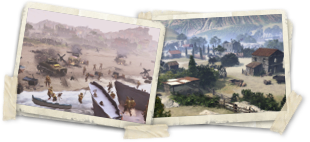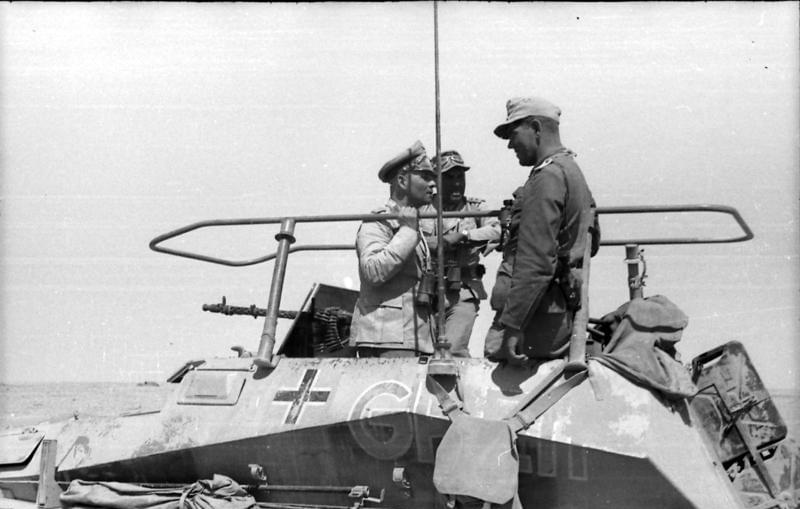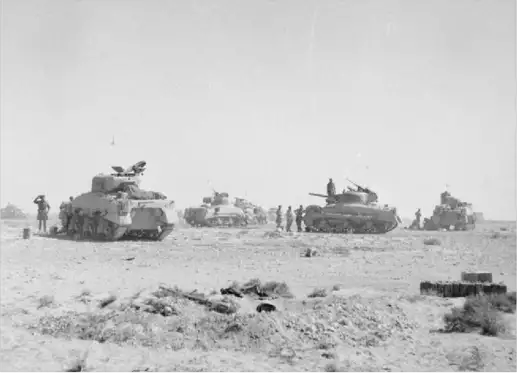July 1-27, 1942
The Allies dig in for the First Battle, flanked by the Mediterranean and the Quattara Depression. However, this ends in a stalemate.
 Experience the dynamic campaign in game with
Experience the dynamic campaign in game with 
 Find out more
Find out moreEl Alamein was a battle of blistering heat, biting sandstorms, and brutal combat. It pitted the ‘desert fox’ Erwin Rommel and his notorious Panzerarmee Afrika, against the resilient Desert Rats of the British Eighth Army.
For the Allies, victory was essential. Threatened with almost total annihilation, they dug in and fought a grim battle of attrition against the fascist war machine.
But how did El Alamein actually play out during WW2? In this guide, we’ll talk you through the background, the battles, and the battalions at its heart.
In 1940, as the Axis juggernaut tore through Europe and the Atlantic, the Allies found a glimmer of hope.
Italy had declared war on Britain and France, and invaded Egypt. But the large Commonwealth garrison stationed there swiftly repelled fascist dictator Benito Mussolini’s forces, pushing them back to the Italian colony of Libya.
It seemed that Britain’s strategic foothold in the eastern Mediterranean, with its rich oil fields and vital Suez Canal shipping route, was safe – for now.
Any optimism proved to be short-lived, however. In February 1941, Erwin Rommel’s Panzerarmee Afrika landed in Tripoli, at roughly the same time Winston Churchill withdrew many of his troops to fight in Greece.
Rommel was a famed commander buoyed by recent victories in France. His wily, tactical genius on the vast deserts of North Africa would earn him a new nickname – the ‘desert fox’.

Erwin Rommel
in his Sd.Kfz. 250/3 command halftrack
Bundesarchiv, Bild 101I-443-1589-07 / Zwilling, Ernst A / CC-BY-SA 3.0
After their chaotic stampede back to El Alamein, Auchinleck and the Eighth Army dug in.
Up until now, Rommel had used the wide, open spaces of the desert to his advantage – sweeping in to attack the Allies from the rear. But at El Alamein, the Allies had geography on their side.
That said, Auchinleck’s determined counterattacks proved equally fruitless. Though the Allied troops had halted the Axis advance, they were unable to dispel them entirely. A long stalemate ensued, where both sides had time to regroup and refuel.
Due to his failure to defeat Rommel’s forces, Churchill dismissed Auchinleck from his position. He was eventually replaced by the energetic but controversial British commander Bernard Montgomery, or ‘Monty’ as he was known to the troops.
The stage was set for a more decisive rematch – the Second Battle of El Alamein.

British infantry 17 July 1942
manning a sandbagged defensive position near El Alamein
The El Alamein line ran for 40 miles from the coast to the Qattara Depression. To the north were divisions from Australia, New Zealand, South Africa, and the United Kingdom, also incorporating troops from India, Sri Lanka, and Poland. To the south, Free French and Greek brigades bolstered British infantry units, while British armoured divisions formed the rear-guard.
Learn more: 'The Tanks of El Alamein and the Desert Wars'
“One of the things to note about the battle,” points out Professor Ball, “is that although the British Eighth forces have a two to one superiority… the air forces are about even.
“So, this isn’t like some of the later battles of the Second World War, in which the Allies have uncontested air superiority.”
The Axis forces during the 2nd battle of El Alamein did however continue to face major supply issues and – unlike their previous desert engagements – they now needed to defend, rather than attack.
To prepare for the Allied advance, Rommel built ‘Devil’s Gardens’: a deep, complex and intimidating network of anti-tank and anti-personnel mines, twisted with barbed wire and backed by anti-tank guns.
Professor Ball notes the sheer scale of the Axis defences:
“There are about 450,000 mines planted along the front line. So, in order to get to the Germans and Italians, the British forces have to cross these mine fields.”
To finally drive Rommel and the Axis out of North Africa, the Allies would require courage, skill, and steely determination.

Deployment of forces on the eve of battle, October 23rd, 1942

 Experience the battle for yourself
Experience the battle for yourselfDownload the game now and see how the battle unfolded
The 2nd battle at El Alamein saw the Axis troops demoralised, depleted, and exhausted. Their intelligence capacity – which had been exceptional up until now due to the presence of armed reconnaissance units in the open desert – had been largely destroyed.
Professor Ball notes that Stumme was effectively going in blind. At the same time, British intelligence was blossoming at Bletchley Park back in England, and feeding communications directly to Cairo. This helped the British cut off Axis supply routes, isolate their forces, and stay one step ahead of the enemy.
In short, warfare was about to become truly modern.
Once the death of Stumme was confirmed, a swift counteroffensive from German and Italian forces aimed to bog down Allied progress.
But it was arguably too late. The Allies had now breached a six-mile-wide and five-mile-deep gap in the Axis line, and advancing British tanks were able to fight back. Montgomery focused his efforts to the north, to inject new energy and progress into the confrontation.
Grim, drawn-out tank warfare raged for a week – a part of the battle variously known as ‘eating the guts’ or the ‘dogfight’ by Montgomery. Both forces captured and recaptured territory without breaking any new ground.
Axis supplies were running low – and Bletchley Park knew it. Churchill was becoming impatient. He wanted to know why Montgomery and his troops weren’t ploughing through the German and Italian lines.
When Rommel returned from the sanitorium, he found a fighting force low on ammo and fuel. While the desert fox did his best to boost morale, he could do little to change the course of the battle – though he did pull divisions up from the south to mount a stubborn defence against the Allies’ slow, steady advance.
Meanwhile, an Australian force sought to capture the Axis position of Thompson’s Post, close to the coastal railway. From there, they aimed to cross to the coast road and attack the rear of the Axis troops. Despite numerous enemy counterattacks, they succeeded.
Rommel was becoming desperate. Meanwhile, Montgomery was about to launch a new offensive – one that would prove a decisive blow against the Axis in North Africa.

Aptly named and powerfully effective, Operation Supercharge was the hammer blow that broke through the remainder of the Axis force. The plan was to drive the fight out of the narrow bottleneck that had been so important to the Allied defence in the first battle of El Alamein. In doing so, they could then outflank the enemy and capture their supply lines.
For Rommel, all was lost. He ordered a retreat – and his message was picked up at Bletchley Park. Montgomery pushed forward hoping for a swift conclusion to this gruelling battle, but the codebreakers back in Britain didn’t pick up Hitler’s response – which was for Rommel’s forces to ‘stand and die’.
The Allies instead came up against brutal resistance from the Axis. Hard fighting persisted on the 3rd of November, with many casualties.
But the trajectory of the battle was now inevitable. Rommel was out of tanks and ordered a second retreat, as Montgomery’s final offensive cleared the remaining German and Italian units to reach open desert.

British infantry advances through the dust and smoke of the battle
El Alamein stayed the steady advance of Axis forces in North Africa, keeping the Suez Canal in Allied hands and preventing the full-scale invasion of Egypt and the Middle East. Along with Stalingrad, it marked the first major Axis setbacks of the war – and pushed them into retreat.
The 9th Australian Division fought in the first and second battles of El Alamein. The division had previously seen gruelling action in the Siege of Tobruk – and were known affectionately as the ‘Rats of Tobruk’.
Around 4,800 Allied troops are believed to have died in the battle of El Alamein, comprising soldiers from not only Britain but across the Commonwealth too.
The Second Battle of El Alamein was quite possibly the most important North African battle of WW2. This marked the point where the tides turned against the Axis forces in North Africa, and across the globe.
American forces landed in North Africa in November 1942. This was part of Operation Torch, and marked the first mass involvement of US troops in the European and North African theatres of the war.
©Relic Entertainment. All rights reserved. Developed by Relic Entertainment. Entertainment, the Relic Entertainment logo, Company of Heroes and the Company of Heroes logo are either registered trademarks or trademarks of Relic Entertainment. Relic Entertainment is registered in the U.S. Patent and Trademark Office. All other trademarks, logos and copyrights are property of their respective owners.